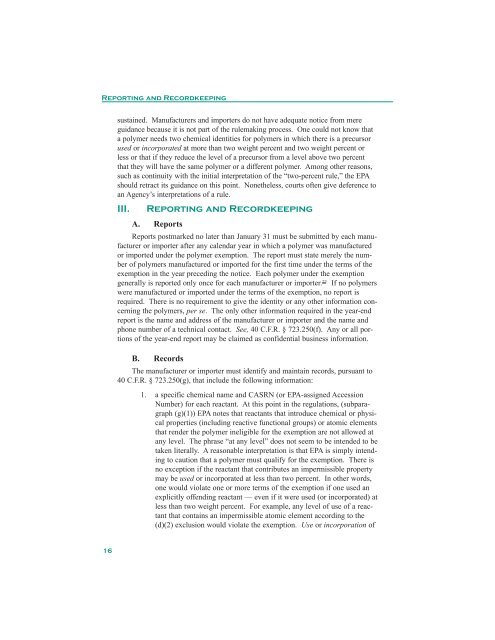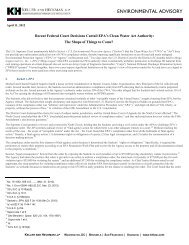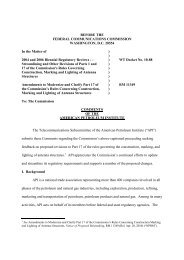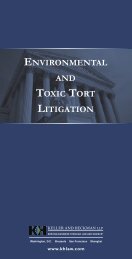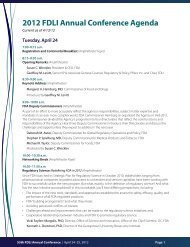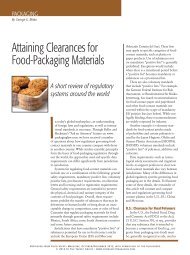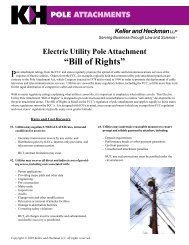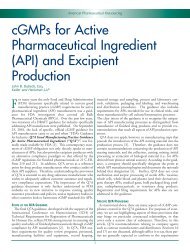A Practical Understanding of the Polymer ... - Keller Heckman
A Practical Understanding of the Polymer ... - Keller Heckman
A Practical Understanding of the Polymer ... - Keller Heckman
You also want an ePaper? Increase the reach of your titles
YUMPU automatically turns print PDFs into web optimized ePapers that Google loves.
Reporting and Recordkeeping<br />
sustained. Manufacturers and importers do not have adequate notice from mere<br />
guidance because it is not part <strong>of</strong> <strong>the</strong> rulemaking process. One could not know that<br />
a polymer needs two chemical identities for polymers in which <strong>the</strong>re is a precursor<br />
used or incorporated at more than two weight percent and two weight percent or<br />
less or that if <strong>the</strong>y reduce <strong>the</strong> level <strong>of</strong> a precursor from a level above two percent<br />
that <strong>the</strong>y will have <strong>the</strong> same polymer or a different polymer. Among o<strong>the</strong>r reasons,<br />
such as continuity with <strong>the</strong> initial interpretation <strong>of</strong> <strong>the</strong> “two-percent rule,” <strong>the</strong> EPA<br />
should retract its guidance on this point. None<strong>the</strong>less, courts <strong>of</strong>ten give deference to<br />
an Agency’s interpretations <strong>of</strong> a rule.<br />
III.<br />
Reporting and Recordkeeping<br />
A. Reports<br />
Reports postmarked no later than January 31 must be submitted by each manufacturer<br />
or importer after any calendar year in which a polymer was manufactured<br />
or imported under <strong>the</strong> polymer exemption. The report must state merely <strong>the</strong> number<br />
<strong>of</strong> polymers manufactured or imported for <strong>the</strong> first time under <strong>the</strong> terms <strong>of</strong> <strong>the</strong><br />
exemption in <strong>the</strong> year preceding <strong>the</strong> notice. Each polymer under <strong>the</strong> exemption<br />
generally is reported only once for each manufacturer or importer. 22/ If no polymers<br />
were manufactured or imported under <strong>the</strong> terms <strong>of</strong> <strong>the</strong> exemption, no report is<br />
required. There is no requirement to give <strong>the</strong> identity or any o<strong>the</strong>r information concerning<br />
<strong>the</strong> polymers, per se. The only o<strong>the</strong>r information required in <strong>the</strong> year-end<br />
report is <strong>the</strong> name and address <strong>of</strong> <strong>the</strong> manufacturer or importer and <strong>the</strong> name and<br />
phone number <strong>of</strong> a technical contact. See, 40 C.F.R. § 723.250(f). Any or all portions<br />
<strong>of</strong> <strong>the</strong> year-end report may be claimed as confidential business information.<br />
B. Records<br />
The manufacturer or importer must identify and maintain records, pursuant to<br />
40 C.F.R. § 723.250(g), that include <strong>the</strong> following information:<br />
1. a specific chemical name and CASRN (or EPA-assigned Accession<br />
Number) for each reactant. At this point in <strong>the</strong> regulations, (subparagraph<br />
(g)(1)) EPA notes that reactants that introduce chemical or physical<br />
properties (including reactive functional groups) or atomic elements<br />
that render <strong>the</strong> polymer ineligible for <strong>the</strong> exemption are not allowed at<br />
any level. The phrase “at any level” does not seem to be intended to be<br />
taken literally. A reasonable interpretation is that EPA is simply intending<br />
to caution that a polymer must qualify for <strong>the</strong> exemption. There is<br />
no exception if <strong>the</strong> reactant that contributes an impermissible property<br />
may be used or incorporated at less than two percent. In o<strong>the</strong>r words,<br />
one would violate one or more terms <strong>of</strong> <strong>the</strong> exemption if one used an<br />
explicitly <strong>of</strong>fending reactant — even if it were used (or incorporated) at<br />
less than two weight percent. For example, any level <strong>of</strong> use <strong>of</strong> a reactant<br />
that contains an impermissible atomic element according to <strong>the</strong><br />
(d)(2) exclusion would violate <strong>the</strong> exemption. Use or incorporation <strong>of</strong><br />
16


